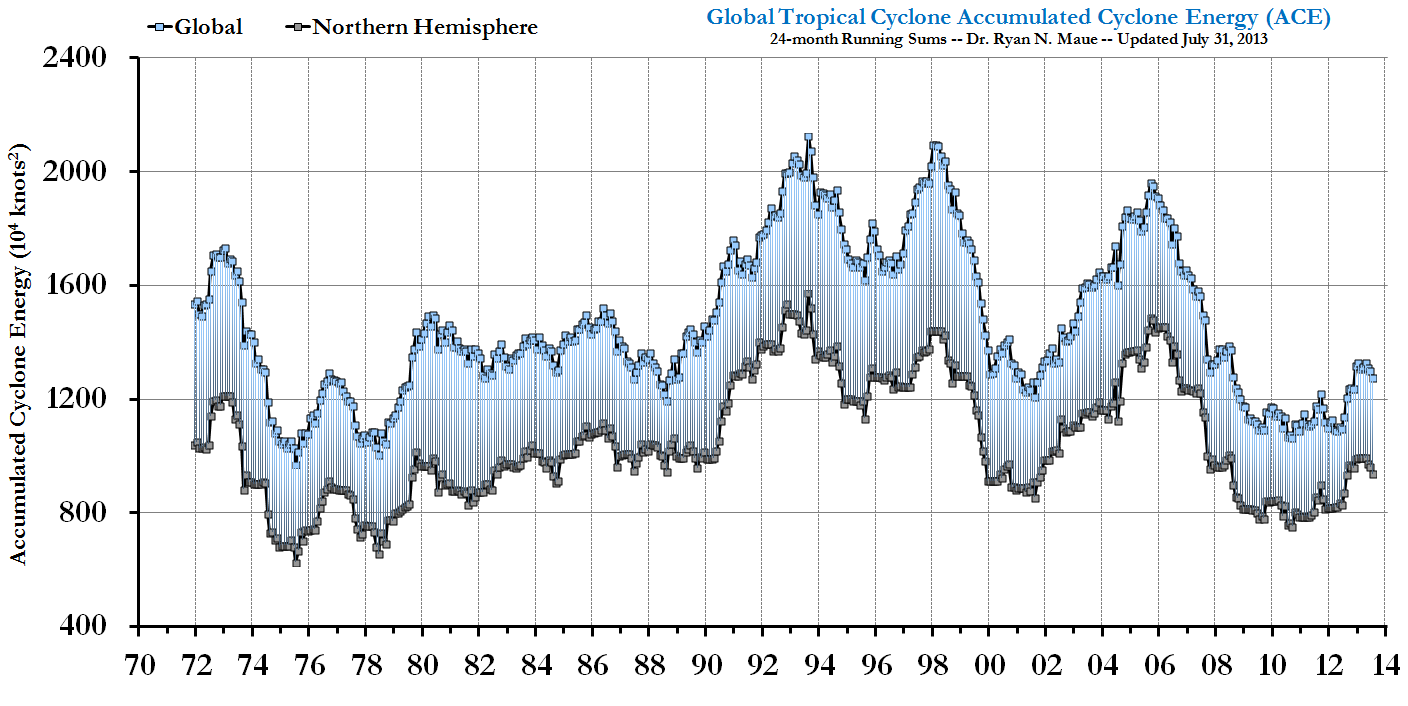yep seen this dumbass, sophomoric theory and, statistically, that 25 "500 year" events is actually very light. hard to look forward when you're blind (and either incredibly stupid or just stuck to an agenda)
(btw in finance the average time between "100 year events" is 2.5 years....of course mental midgets take this literally to mean chaos only ever happens every 100 years but they are talking about one single item out of millions that happens once in 100 years. just like the 500 year storm theory applies to each individual town/city in america and when you add them up 25 in 7.5 years is statistically tiny)
here is the statistical response that you can find in many places...
In a one-year window we have a mean of <nobr aria-hidden="true" style="transition: none; border: 0px; padding: 0px; margin: 0px; max-width: none; max-height: none; min-width: 0px; min-height: 0px; vertical-align: 0px; line-height: normal;">[FONT=MathJax_Main]1[FONT=MathJax_Main]500</nobr><math xmlns="http://www.w3.org/1998/Math/MathML"><mfrac><mn>1</mn><mn>500</mn></mfrac></math>[/FONT] 500-year storms occurring. In a 15-month (<nobr aria-hidden="true" style="transition: none; border: 0px; padding: 0px; margin: 0px; max-width: none; max-height: none; min-width: 0px; min-height: 0px; vertical-align: 0px; line-height: normal;">[FONT=MathJax_Main]5[FONT=MathJax_Main]4[/FONT]</nobr><math xmlns="http://www.w3.org/1998/Math/MathML"><mfrac><mn>5</mn><mn>4</mn></mfrac></math>[/FONT] year) window we would thus expect a mean of <nobr aria-hidden="true" style="transition: none; border: 0px; padding: 0px; margin: 0px; max-width: none; max-height: none; min-width: 0px; min-height: 0px; vertical-align: 0px; line-height: normal;">[FONT=MathJax_Main]1[FONT=MathJax_Main]500[FONT=MathJax_Main]×[FONT=MathJax_Main]5[FONT=MathJax_Main]4[FONT=MathJax_Main]=[/FONT][FONT=MathJax_Main]1[FONT=MathJax_Main]400[/FONT][/FONT][/FONT][/FONT][/FONT][/FONT]</nobr><math xmlns="http://www.w3.org/1998/Math/MathML"><mfrac><mn>1</mn><mn>500</mn></mfrac><mo>×</mo><mfrac><mn>5</mn><mn>4</mn></mfrac><mo>=</mo><mfrac><mn>1</mn><mn>400</mn></mfrac></math>[/FONT] storms.[/FONT]
Now assuming the independence of storms, we will model them by the Poisson distribution. This distribution has one parameter, the mean, which is <nobr aria-hidden="true" style="transition: none; border: 0px; padding: 0px; margin: 0px; max-width: none; max-height: none; min-width: 0px; min-height: 0px; vertical-align: 0px; line-height: normal;">[FONT=MathJax_Math-italic]λ[FONT=MathJax_Main]=[FONT=MathJax_Main]1[FONT=MathJax_Main]400[/FONT][/FONT]</nobr><math xmlns="http://www.w3.org/1998/Math/MathML"><mi>λ</mi><mo>=</mo><mfrac><mn>1</mn><mn>400</mn></mfrac></math>[/FONT] here. Given a window and a mean, the probability that k events occur in the window is[/FONT]
<nobr aria-hidden="true" style="transition: none; border: 0px; padding: 0px; margin: 0px; max-width: none; max-height: none; min-width: 0px; min-height: 0px; vertical-align: 0px; line-height: normal;">[FONT=MathJax_Math-italic]λ[FONT=MathJax_Math-italic]k[FONT=MathJax_Math-italic]e[FONT=MathJax_Main]−[FONT=MathJax_Math-italic]λ[FONT=MathJax_Math-italic]k[FONT=MathJax_Main]![/FONT][/FONT][/FONT][/FONT][/FONT]</nobr><math xmlns="http://www.w3.org/1998/Math/MathML" display="block"><mfrac><mrow><msup><mi>λ</mi><mi>k</mi></msup><msup><mi>e</mi><mrow class="MJX-TeXAtom-ORD"><mo>−</mo><mi>λ</mi></mrow></msup></mrow><mrow><mi>k</mi><mo>!</mo></mrow></mfrac></math>[/FONT][/FONT]Substituting the values in, we get a probability of <nobr aria-hidden="true" style="transition: none; border: 0px; padding: 0px; margin: 0px; max-width: none; max-height: none; min-width: 0px; min-height: 0px; vertical-align: 0px; line-height: normal;">[FONT=MathJax_Main]3.775[FONT=MathJax_Main]×[FONT=MathJax_Main]10[FONT=MathJax_Main]−[FONT=MathJax_Main]26[/FONT][/FONT][/FONT][/FONT]</nobr><math xmlns="http://www.w3.org/1998/Math/MathML"><mn>3.775</mn><mo>×</mo><msup><mn>10</mn><mrow class="MJX-TeXAtom-ORD"><mo>−</mo><mn>26</mn></mrow></msup></math>[/FONT] that eight 500-year storms happen in 15 months.
...so there fella if statistically you can expect eight 500-year storms every 15 months in the USA then the timeframe you're working with (7.5 years) would have seem about 48 of these "500 year storms", not just the 25 that have been noted.
so now that we've dispelled your new storm (no longer hurricanes, i see....lol) notion maybe we can go for forest fires or droughts, how about snowfalls or hail events? please, entertain me
Since you know it all ......when will the next 500 year storm hit the Houston area.....I want to mark my calendar? By the way I didn't miss even one math question on my college entrance test and had a full ride academic scholarship....probably not many on the site will be able to say the same thing. How does that song go by Shania Twain....Okay, so you're a rocket scientist...that don't impress me much.






